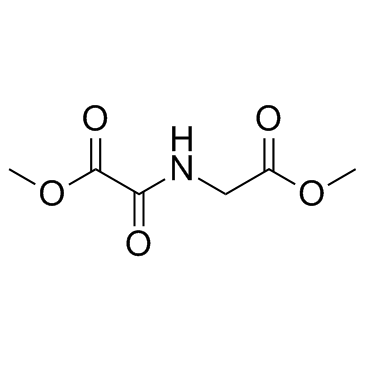Dimethyloxalylglycine

Dimethyloxalylglycine structure
|
Common Name | Dimethyloxalylglycine | ||
|---|---|---|---|---|
| CAS Number | 89464-63-1 | Molecular Weight | 175.139 | |
| Density | 1.2±0.1 g/cm3 | Boiling Point | N/A | |
| Molecular Formula | C6H9NO5 | Melting Point | 46-48ºC | |
| MSDS | Chinese USA | Flash Point | N/A | |
| Symbol |

GHS07 |
Signal Word | Warning | |
|
Anti-chondroitin sulfate proteoglycan 4-specific antibodies modify the effects of vemurafenib on melanoma cells differentially in normoxia and hypoxia.
Int. J. Oncol. 47 , 81-90, (2015) Chondroitin sulfate proteoglycan 4 (CSPG4), a highly immunogenic melanoma tumor antigen, is a potential target for antibody-based immunotherapy. The mechanism by which CSPG4 affects melanoma progression is only partly understood, in particular the involvement... |
|
|
A novel effect of DMOG on cell metabolism: direct inhibition of mitochondrial function precedes HIF target gene expression.
Biochim. Biophys. Acta 1847 , 1254-66, (2015) Abnormal accumulation of oncometabolite fumarate and succinate is associated with inhibition of mitochondrial function and carcinogenesis. By competing with α-ketoglutarate, oncometabolites also activate hypoxia inducible factors (HIFs), which makes oncometab... |
|
|
Hypoxia lowers SLC30A8/ZnT8 expression and free cytosolic Zn2+ in pancreatic beta cells.
Diabetologia 57(8) , 1635-44, (2014) Hypoxic damage complicates islet isolation for transplantation and may contribute to beta cell failure in type 2 diabetes. Polymorphisms in the SLC30A8 gene, encoding the secretory granule zinc transporter 8 (ZnT8), influence type 2 diabetes risk, conceivably... |
|
|
PHD3 Stabilizes the Tight Junction Protein Occludin and Protects Intestinal Epithelial Barrier Function.
J. Biol. Chem. 290 , 20580-9, (2015) Prolyl hydroxylase domain proteins (PHDs) control cellular adaptation to hypoxia. PHDs are found involved in inflammatory bowel disease (IBD); however, the exact role of PHD3, a member of the PHD family, in IBD remains unknown. We show here that PHD3 plays a ... |
|
|
Pluripotency transcription factor Oct4 mediates stepwise nucleosome demethylation and depletion.
Mol. Cell. Biol. 35(6) , 1014-25, (2015) The mechanisms whereby the crucial pluripotency transcription factor Oct4 regulates target gene expression are incompletely understood. Using an assay system based on partially differentiated embryonic stem cells, we show that Oct4 opposes the accumulation of... |
|
|
Effects of dimethyloxalylglycine on wound healing of palatal mucosa in a rat model.
BMC Oral Health 15 , 60, (2015) Rapid wound healing of oral soft tissue may reduce the opportunity of infection and discomfort of patients. Previous studies have demonstrated that enhancement of angiogenesis is an effective way to accelerate wound repair. In this study, to enhance angiogene... |
|
|
Aquaporin 1 and 5 expression decreases during human intervertebral disc degeneration: Novel HIF-1-mediated regulation of aquaporins in NP cells.
Oncotarget 6 , 11945-58, (2015) Objectives of this study were to investigate whether AQP1 and AQP5 expression is altered during intervertebral disc degeneration and if hypoxia and HIF-1 regulate their expression in NP cells. AQP expression was measured in human tissues from different degene... |
|
|
Hypoxia-inducible TAp73 supports tumorigenesis by regulating the angiogenic transcriptome.
Nat. Cell Biol. 17(4) , 511-23, (2015) The functional significance of the overexpression of unmutated TAp73, a homologue of the tumour suppressor p53, in multiple human cancers is unclear, but raises the possibility of unidentified roles in promoting tumorigenesis. We show here that TAp73 is stabi... |
|
|
Hypoxia leads to abnormal epidermal differentiation via HIF-independent pathways.
Biochem. Biophys. Res. Commun. 469 , 251-6, (2016) Atmospheric oxygen is important for the epidermis, as the skin epidermis is not greatly affected by blood circulation. Therefore, it is necessary to understand the effect of hypoxic signals on the epidermis as some environmental stimuli can induce skin hypoxi... |
|
|
miR-372 inhibits p62 in head and neck squamous cell carcinoma in vitro and in vivo.
Oncotarget 6(8) , 6062-75, (2015) Here we showed that exogenous miR-372 expression and knockdown of p62 (sequestosome1 or SQSTM1), both increased migration of head and neck squamous cell carcinoma (HNSCC) cells. p62 induced phase II detoxification enzyme NADPH quinone oxidoreductase 1 (NQO1),... |